HI5020 Corporate Accounting: In-depth Analysis of CSR Ltd's Financials
VerifiedAdded on 2024/04/26
|13
|2478
|60
Report
AI Summary
This project report provides an in-depth analysis of CSR Ltd.'s financial statements, focusing on income tax expenses, deferred tax assets and liabilities, and equity components. It examines the differences between accounting income and taxable income, highlighting the impact of these differences on the financial statements. The report covers key aspects such as issued capital, reserves, retained profits, current and deferred tax expenses, and the treatment of taxable income. It also discusses the balance sheet liability method used by CSR Limited for calculating deferred income tax. The analysis refers to the company's 2016 annual report and relevant accounting standards to provide a comprehensive understanding of the company's financial position and performance. The report concludes by emphasizing the importance of understanding income tax aspects for business enterprises and highlights the satisfactory treatment of taxable income and tax payable in CSR Ltd.'s annual report.

HI5020 – Corporate Accounting
1
1
Paraphrase This Document
Need a fresh take? Get an instant paraphrase of this document with our AI Paraphraser
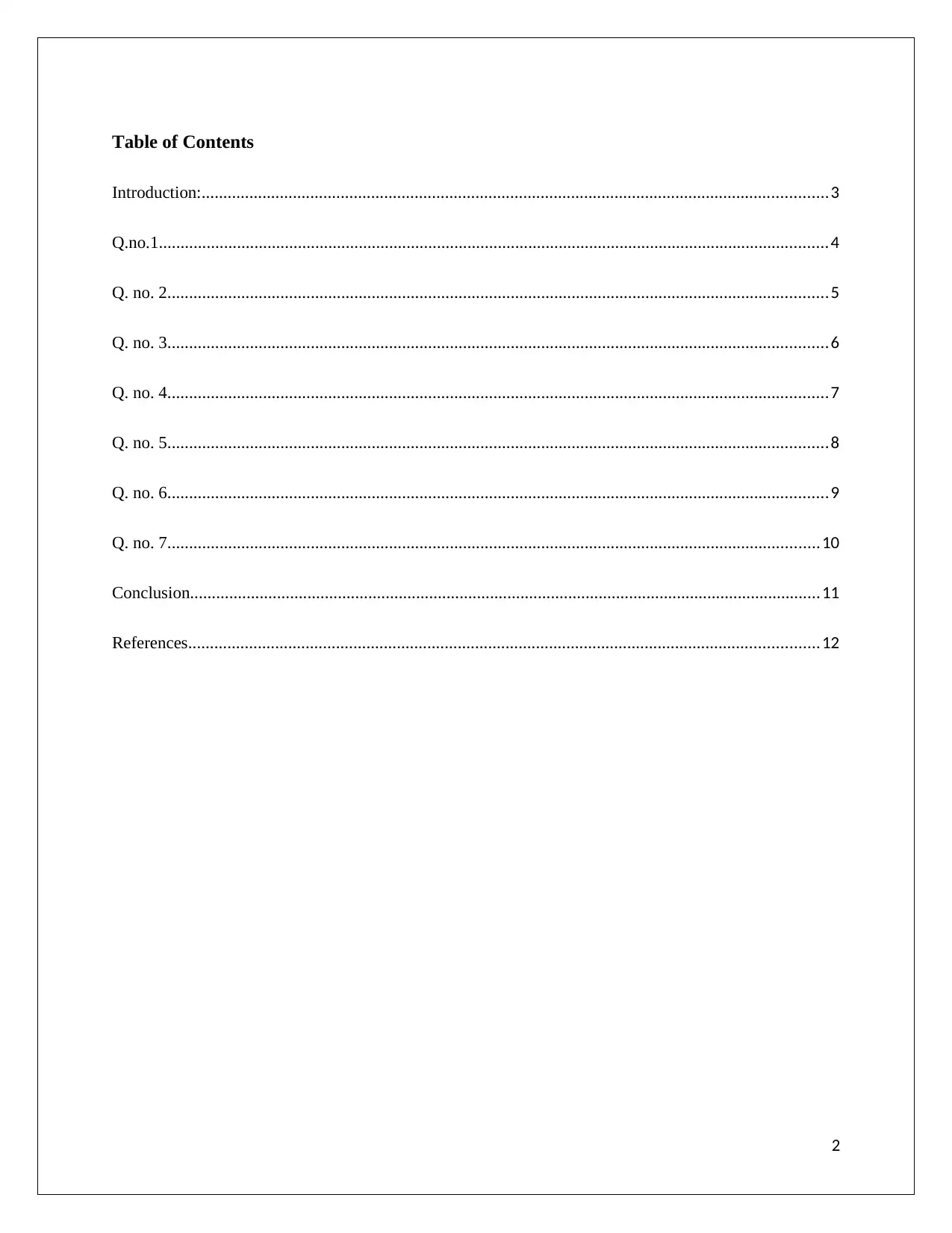
Table of Contents
Introduction:................................................................................................................................................3
Q.no.1..........................................................................................................................................................4
Q. no. 2........................................................................................................................................................5
Q. no. 3........................................................................................................................................................6
Q. no. 4........................................................................................................................................................7
Q. no. 5........................................................................................................................................................8
Q. no. 6........................................................................................................................................................9
Q. no. 7......................................................................................................................................................10
Conclusion.................................................................................................................................................11
References.................................................................................................................................................12
2
Introduction:................................................................................................................................................3
Q.no.1..........................................................................................................................................................4
Q. no. 2........................................................................................................................................................5
Q. no. 3........................................................................................................................................................6
Q. no. 4........................................................................................................................................................7
Q. no. 5........................................................................................................................................................8
Q. no. 6........................................................................................................................................................9
Q. no. 7......................................................................................................................................................10
Conclusion.................................................................................................................................................11
References.................................................................................................................................................12
2
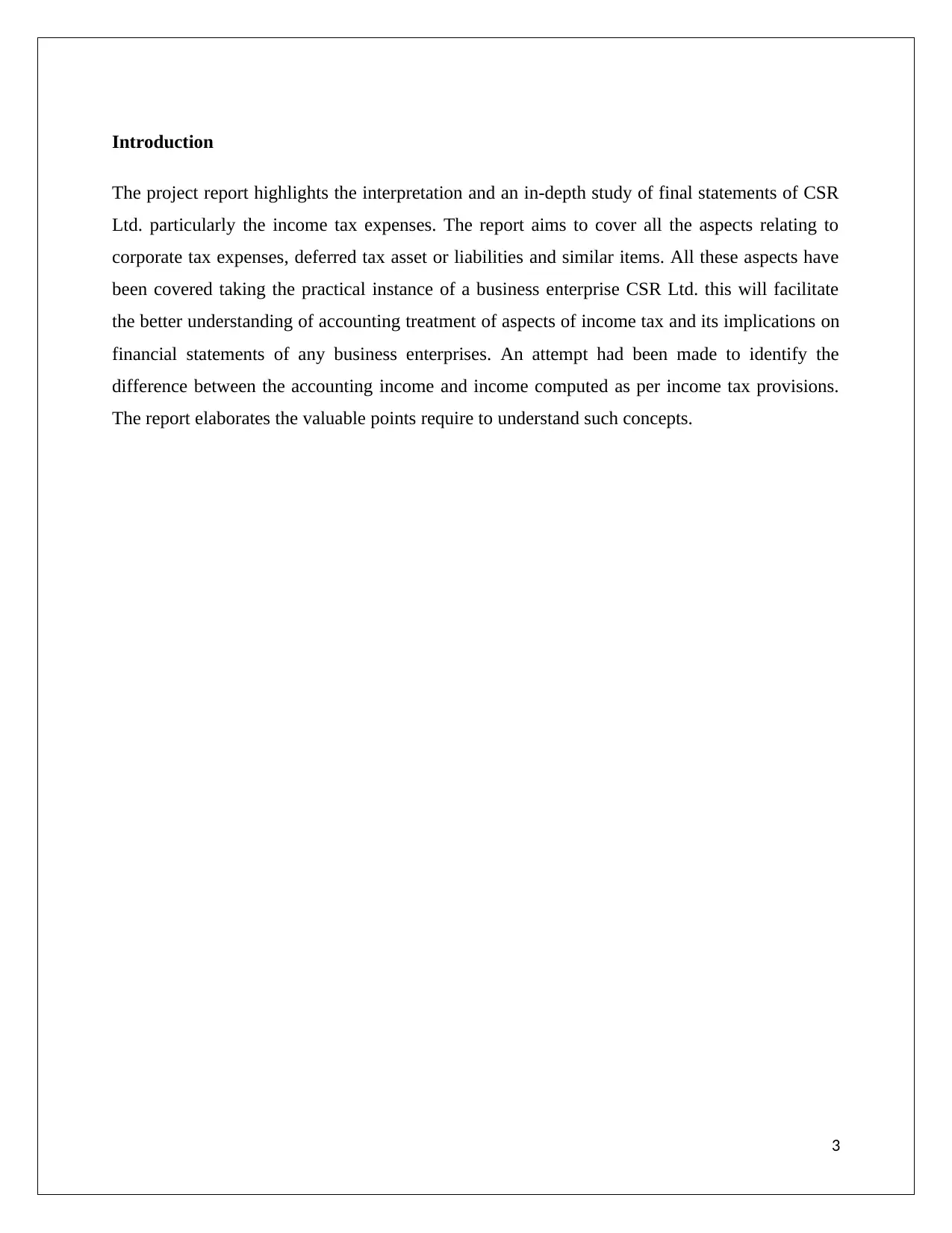
Introduction
The project report highlights the interpretation and an in-depth study of final statements of CSR
Ltd. particularly the income tax expenses. The report aims to cover all the aspects relating to
corporate tax expenses, deferred tax asset or liabilities and similar items. All these aspects have
been covered taking the practical instance of a business enterprise CSR Ltd. this will facilitate
the better understanding of accounting treatment of aspects of income tax and its implications on
financial statements of any business enterprises. An attempt had been made to identify the
difference between the accounting income and income computed as per income tax provisions.
The report elaborates the valuable points require to understand such concepts.
3
The project report highlights the interpretation and an in-depth study of final statements of CSR
Ltd. particularly the income tax expenses. The report aims to cover all the aspects relating to
corporate tax expenses, deferred tax asset or liabilities and similar items. All these aspects have
been covered taking the practical instance of a business enterprise CSR Ltd. this will facilitate
the better understanding of accounting treatment of aspects of income tax and its implications on
financial statements of any business enterprises. An attempt had been made to identify the
difference between the accounting income and income computed as per income tax provisions.
The report elaborates the valuable points require to understand such concepts.
3
⊘ This is a preview!⊘
Do you want full access?
Subscribe today to unlock all pages.

Trusted by 1+ million students worldwide
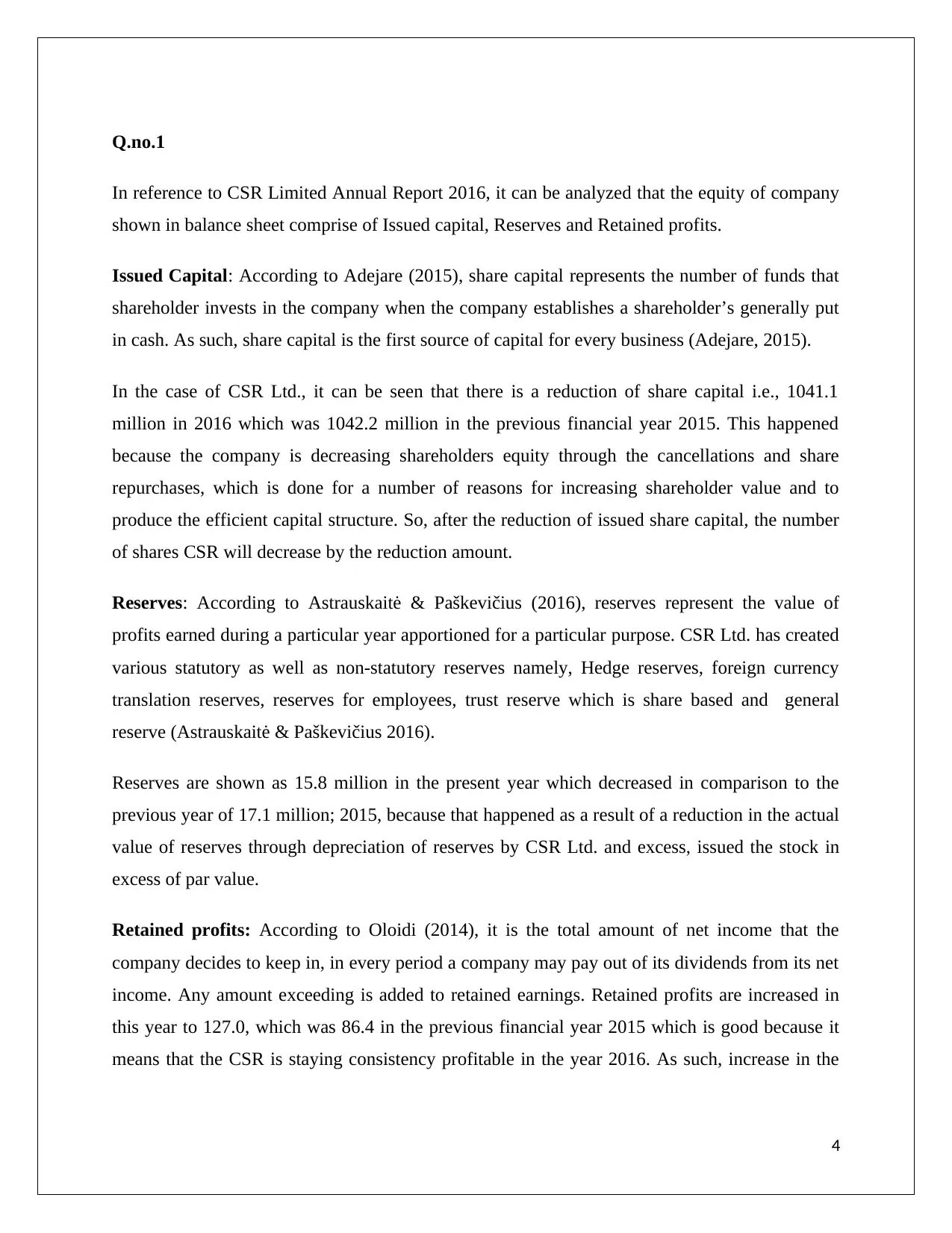
Q.no.1
In reference to CSR Limited Annual Report 2016, it can be analyzed that the equity of company
shown in balance sheet comprise of Issued capital, Reserves and Retained profits.
Issued Capital: According to Adejare (2015), share capital represents the number of funds that
shareholder invests in the company when the company establishes a shareholder’s generally put
in cash. As such, share capital is the first source of capital for every business (Adejare, 2015).
In the case of CSR Ltd., it can be seen that there is a reduction of share capital i.e., 1041.1
million in 2016 which was 1042.2 million in the previous financial year 2015. This happened
because the company is decreasing shareholders equity through the cancellations and share
repurchases, which is done for a number of reasons for increasing shareholder value and to
produce the efficient capital structure. So, after the reduction of issued share capital, the number
of shares CSR will decrease by the reduction amount.
Reserves: According to Astrauskaitė & Paškevičius (2016), reserves represent the value of
profits earned during a particular year apportioned for a particular purpose. CSR Ltd. has created
various statutory as well as non-statutory reserves namely, Hedge reserves, foreign currency
translation reserves, reserves for employees, trust reserve which is share based and general
reserve (Astrauskaitė & Paškevičius 2016).
Reserves are shown as 15.8 million in the present year which decreased in comparison to the
previous year of 17.1 million; 2015, because that happened as a result of a reduction in the actual
value of reserves through depreciation of reserves by CSR Ltd. and excess, issued the stock in
excess of par value.
Retained profits: According to Oloidi (2014), it is the total amount of net income that the
company decides to keep in, in every period a company may pay out of its dividends from its net
income. Any amount exceeding is added to retained earnings. Retained profits are increased in
this year to 127.0, which was 86.4 in the previous financial year 2015 which is good because it
means that the CSR is staying consistency profitable in the year 2016. As such, increase in the
4
In reference to CSR Limited Annual Report 2016, it can be analyzed that the equity of company
shown in balance sheet comprise of Issued capital, Reserves and Retained profits.
Issued Capital: According to Adejare (2015), share capital represents the number of funds that
shareholder invests in the company when the company establishes a shareholder’s generally put
in cash. As such, share capital is the first source of capital for every business (Adejare, 2015).
In the case of CSR Ltd., it can be seen that there is a reduction of share capital i.e., 1041.1
million in 2016 which was 1042.2 million in the previous financial year 2015. This happened
because the company is decreasing shareholders equity through the cancellations and share
repurchases, which is done for a number of reasons for increasing shareholder value and to
produce the efficient capital structure. So, after the reduction of issued share capital, the number
of shares CSR will decrease by the reduction amount.
Reserves: According to Astrauskaitė & Paškevičius (2016), reserves represent the value of
profits earned during a particular year apportioned for a particular purpose. CSR Ltd. has created
various statutory as well as non-statutory reserves namely, Hedge reserves, foreign currency
translation reserves, reserves for employees, trust reserve which is share based and general
reserve (Astrauskaitė & Paškevičius 2016).
Reserves are shown as 15.8 million in the present year which decreased in comparison to the
previous year of 17.1 million; 2015, because that happened as a result of a reduction in the actual
value of reserves through depreciation of reserves by CSR Ltd. and excess, issued the stock in
excess of par value.
Retained profits: According to Oloidi (2014), it is the total amount of net income that the
company decides to keep in, in every period a company may pay out of its dividends from its net
income. Any amount exceeding is added to retained earnings. Retained profits are increased in
this year to 127.0, which was 86.4 in the previous financial year 2015 which is good because it
means that the CSR is staying consistency profitable in the year 2016. As such, increase in the
4
Paraphrase This Document
Need a fresh take? Get an instant paraphrase of this document with our AI Paraphraser
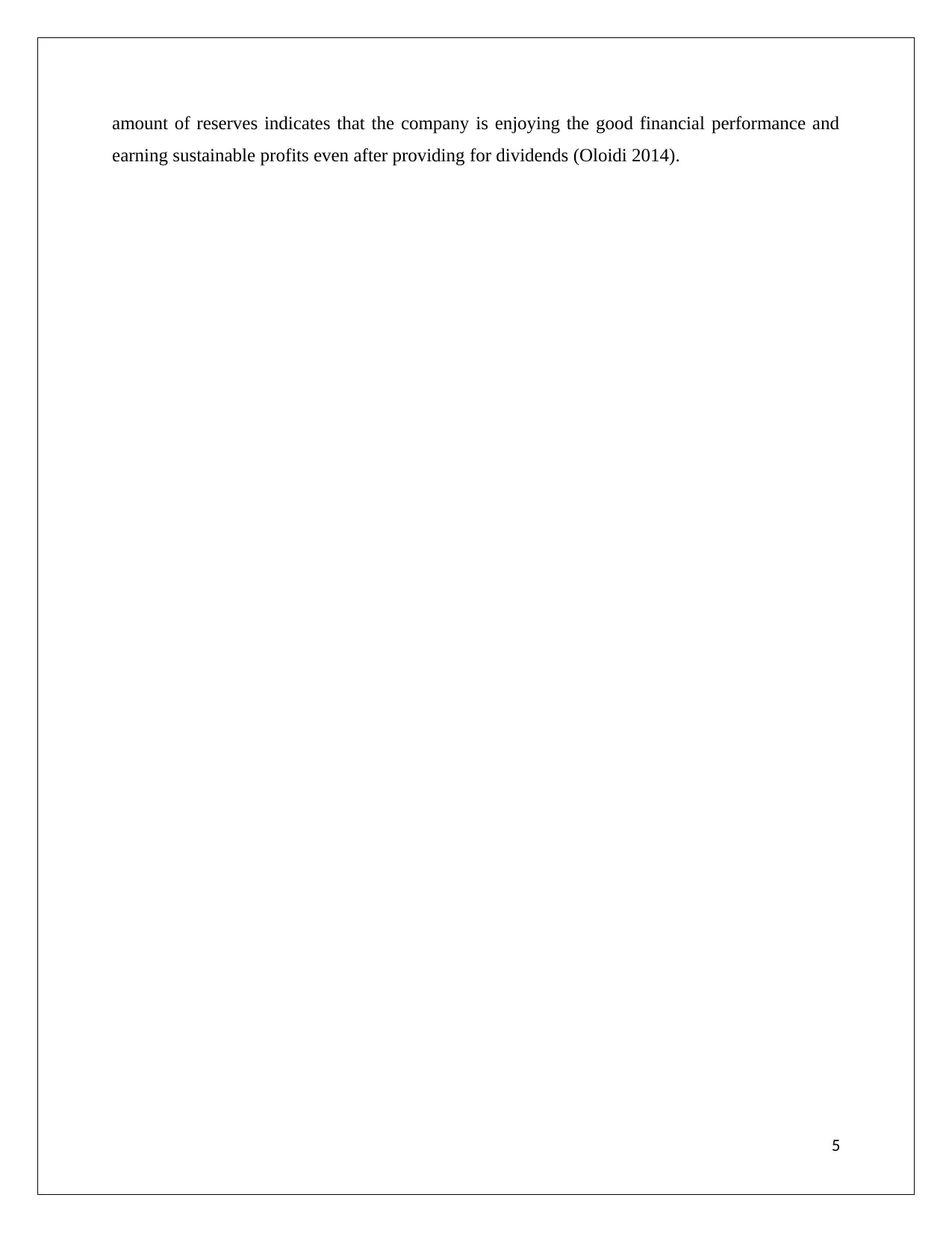
amount of reserves indicates that the company is enjoying the good financial performance and
earning sustainable profits even after providing for dividends (Oloidi 2014).
5
earning sustainable profits even after providing for dividends (Oloidi 2014).
5
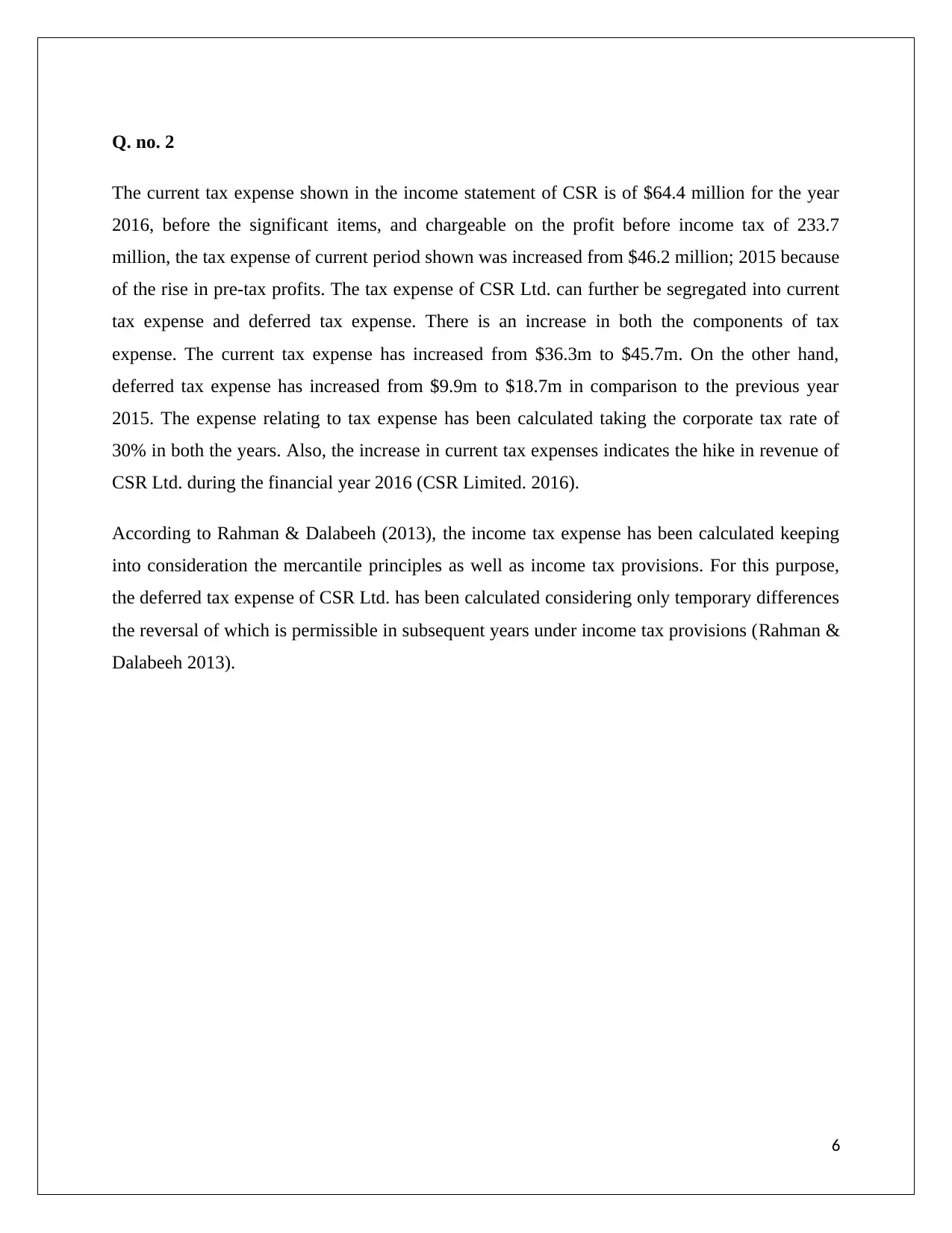
Q. no. 2
The current tax expense shown in the income statement of CSR is of $64.4 million for the year
2016, before the significant items, and chargeable on the profit before income tax of 233.7
million, the tax expense of current period shown was increased from $46.2 million; 2015 because
of the rise in pre-tax profits. The tax expense of CSR Ltd. can further be segregated into current
tax expense and deferred tax expense. There is an increase in both the components of tax
expense. The current tax expense has increased from $36.3m to $45.7m. On the other hand,
deferred tax expense has increased from $9.9m to $18.7m in comparison to the previous year
2015. The expense relating to tax expense has been calculated taking the corporate tax rate of
30% in both the years. Also, the increase in current tax expenses indicates the hike in revenue of
CSR Ltd. during the financial year 2016 (CSR Limited. 2016).
According to Rahman & Dalabeeh (2013), the income tax expense has been calculated keeping
into consideration the mercantile principles as well as income tax provisions. For this purpose,
the deferred tax expense of CSR Ltd. has been calculated considering only temporary differences
the reversal of which is permissible in subsequent years under income tax provisions (Rahman &
Dalabeeh 2013).
6
The current tax expense shown in the income statement of CSR is of $64.4 million for the year
2016, before the significant items, and chargeable on the profit before income tax of 233.7
million, the tax expense of current period shown was increased from $46.2 million; 2015 because
of the rise in pre-tax profits. The tax expense of CSR Ltd. can further be segregated into current
tax expense and deferred tax expense. There is an increase in both the components of tax
expense. The current tax expense has increased from $36.3m to $45.7m. On the other hand,
deferred tax expense has increased from $9.9m to $18.7m in comparison to the previous year
2015. The expense relating to tax expense has been calculated taking the corporate tax rate of
30% in both the years. Also, the increase in current tax expenses indicates the hike in revenue of
CSR Ltd. during the financial year 2016 (CSR Limited. 2016).
According to Rahman & Dalabeeh (2013), the income tax expense has been calculated keeping
into consideration the mercantile principles as well as income tax provisions. For this purpose,
the deferred tax expense of CSR Ltd. has been calculated considering only temporary differences
the reversal of which is permissible in subsequent years under income tax provisions (Rahman &
Dalabeeh 2013).
6
⊘ This is a preview!⊘
Do you want full access?
Subscribe today to unlock all pages.

Trusted by 1+ million students worldwide
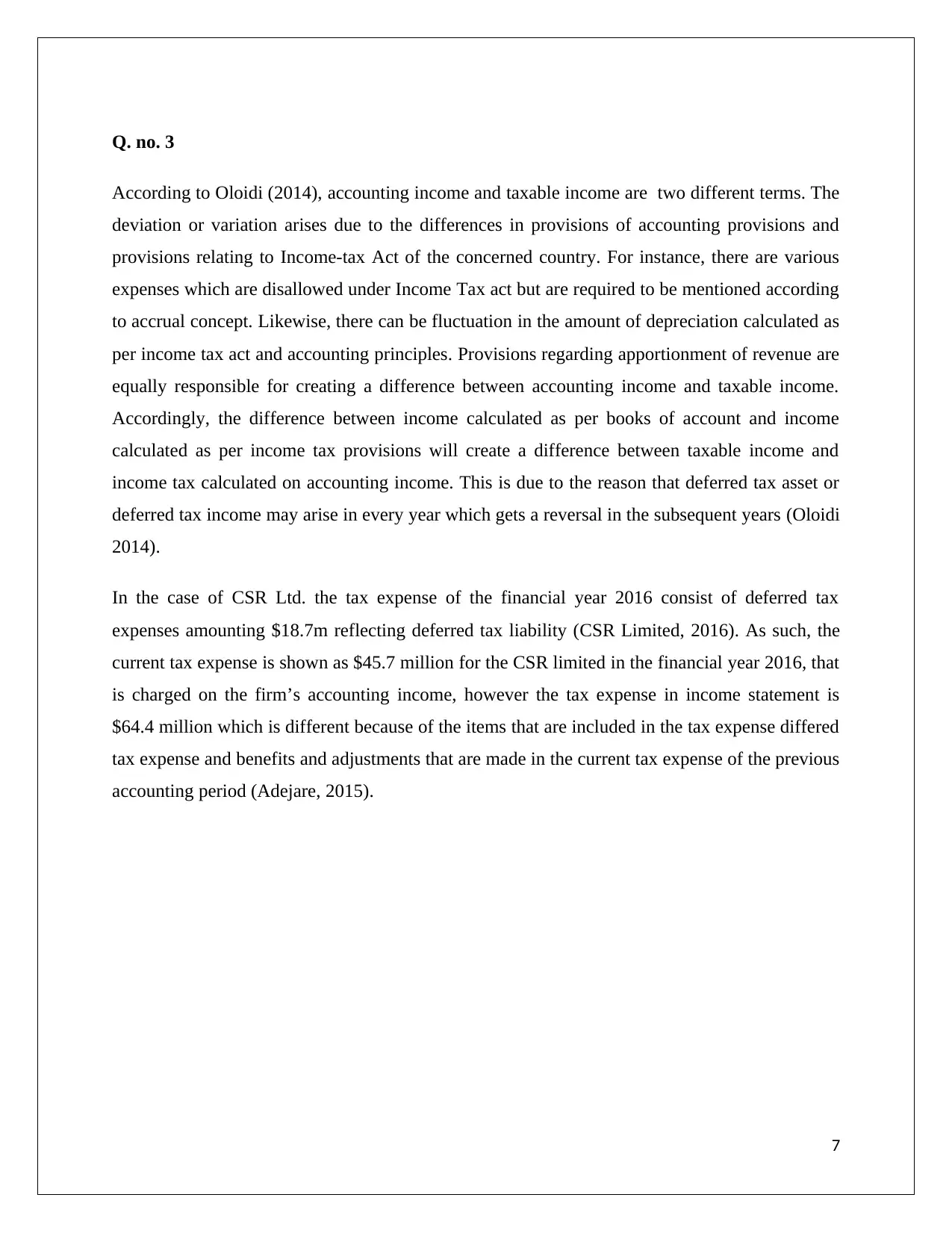
Q. no. 3
According to Oloidi (2014), accounting income and taxable income are two different terms. The
deviation or variation arises due to the differences in provisions of accounting provisions and
provisions relating to Income-tax Act of the concerned country. For instance, there are various
expenses which are disallowed under Income Tax act but are required to be mentioned according
to accrual concept. Likewise, there can be fluctuation in the amount of depreciation calculated as
per income tax act and accounting principles. Provisions regarding apportionment of revenue are
equally responsible for creating a difference between accounting income and taxable income.
Accordingly, the difference between income calculated as per books of account and income
calculated as per income tax provisions will create a difference between taxable income and
income tax calculated on accounting income. This is due to the reason that deferred tax asset or
deferred tax income may arise in every year which gets a reversal in the subsequent years (Oloidi
2014).
In the case of CSR Ltd. the tax expense of the financial year 2016 consist of deferred tax
expenses amounting $18.7m reflecting deferred tax liability (CSR Limited, 2016). As such, the
current tax expense is shown as $45.7 million for the CSR limited in the financial year 2016, that
is charged on the firm’s accounting income, however the tax expense in income statement is
$64.4 million which is different because of the items that are included in the tax expense differed
tax expense and benefits and adjustments that are made in the current tax expense of the previous
accounting period (Adejare, 2015).
7
According to Oloidi (2014), accounting income and taxable income are two different terms. The
deviation or variation arises due to the differences in provisions of accounting provisions and
provisions relating to Income-tax Act of the concerned country. For instance, there are various
expenses which are disallowed under Income Tax act but are required to be mentioned according
to accrual concept. Likewise, there can be fluctuation in the amount of depreciation calculated as
per income tax act and accounting principles. Provisions regarding apportionment of revenue are
equally responsible for creating a difference between accounting income and taxable income.
Accordingly, the difference between income calculated as per books of account and income
calculated as per income tax provisions will create a difference between taxable income and
income tax calculated on accounting income. This is due to the reason that deferred tax asset or
deferred tax income may arise in every year which gets a reversal in the subsequent years (Oloidi
2014).
In the case of CSR Ltd. the tax expense of the financial year 2016 consist of deferred tax
expenses amounting $18.7m reflecting deferred tax liability (CSR Limited, 2016). As such, the
current tax expense is shown as $45.7 million for the CSR limited in the financial year 2016, that
is charged on the firm’s accounting income, however the tax expense in income statement is
$64.4 million which is different because of the items that are included in the tax expense differed
tax expense and benefits and adjustments that are made in the current tax expense of the previous
accounting period (Adejare, 2015).
7
Paraphrase This Document
Need a fresh take? Get an instant paraphrase of this document with our AI Paraphraser
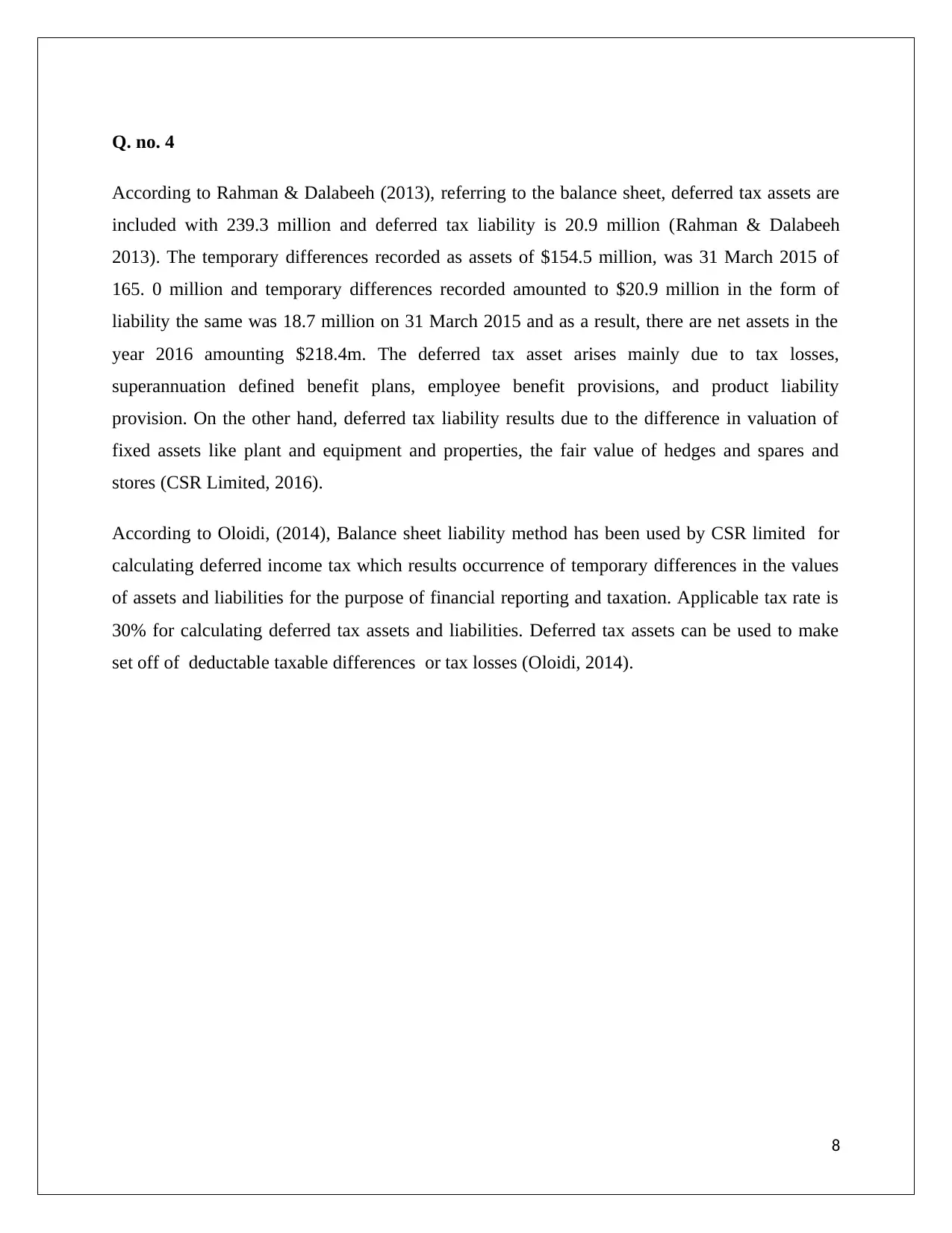
Q. no. 4
According to Rahman & Dalabeeh (2013), referring to the balance sheet, deferred tax assets are
included with 239.3 million and deferred tax liability is 20.9 million (Rahman & Dalabeeh
2013). The temporary differences recorded as assets of $154.5 million, was 31 March 2015 of
165. 0 million and temporary differences recorded amounted to $20.9 million in the form of
liability the same was 18.7 million on 31 March 2015 and as a result, there are net assets in the
year 2016 amounting $218.4m. The deferred tax asset arises mainly due to tax losses,
superannuation defined benefit plans, employee benefit provisions, and product liability
provision. On the other hand, deferred tax liability results due to the difference in valuation of
fixed assets like plant and equipment and properties, the fair value of hedges and spares and
stores (CSR Limited, 2016).
According to Oloidi, (2014), Balance sheet liability method has been used by CSR limited for
calculating deferred income tax which results occurrence of temporary differences in the values
of assets and liabilities for the purpose of financial reporting and taxation. Applicable tax rate is
30% for calculating deferred tax assets and liabilities. Deferred tax assets can be used to make
set off of deductable taxable differences or tax losses (Oloidi, 2014).
8
According to Rahman & Dalabeeh (2013), referring to the balance sheet, deferred tax assets are
included with 239.3 million and deferred tax liability is 20.9 million (Rahman & Dalabeeh
2013). The temporary differences recorded as assets of $154.5 million, was 31 March 2015 of
165. 0 million and temporary differences recorded amounted to $20.9 million in the form of
liability the same was 18.7 million on 31 March 2015 and as a result, there are net assets in the
year 2016 amounting $218.4m. The deferred tax asset arises mainly due to tax losses,
superannuation defined benefit plans, employee benefit provisions, and product liability
provision. On the other hand, deferred tax liability results due to the difference in valuation of
fixed assets like plant and equipment and properties, the fair value of hedges and spares and
stores (CSR Limited, 2016).
According to Oloidi, (2014), Balance sheet liability method has been used by CSR limited for
calculating deferred income tax which results occurrence of temporary differences in the values
of assets and liabilities for the purpose of financial reporting and taxation. Applicable tax rate is
30% for calculating deferred tax assets and liabilities. Deferred tax assets can be used to make
set off of deductable taxable differences or tax losses (Oloidi, 2014).
8
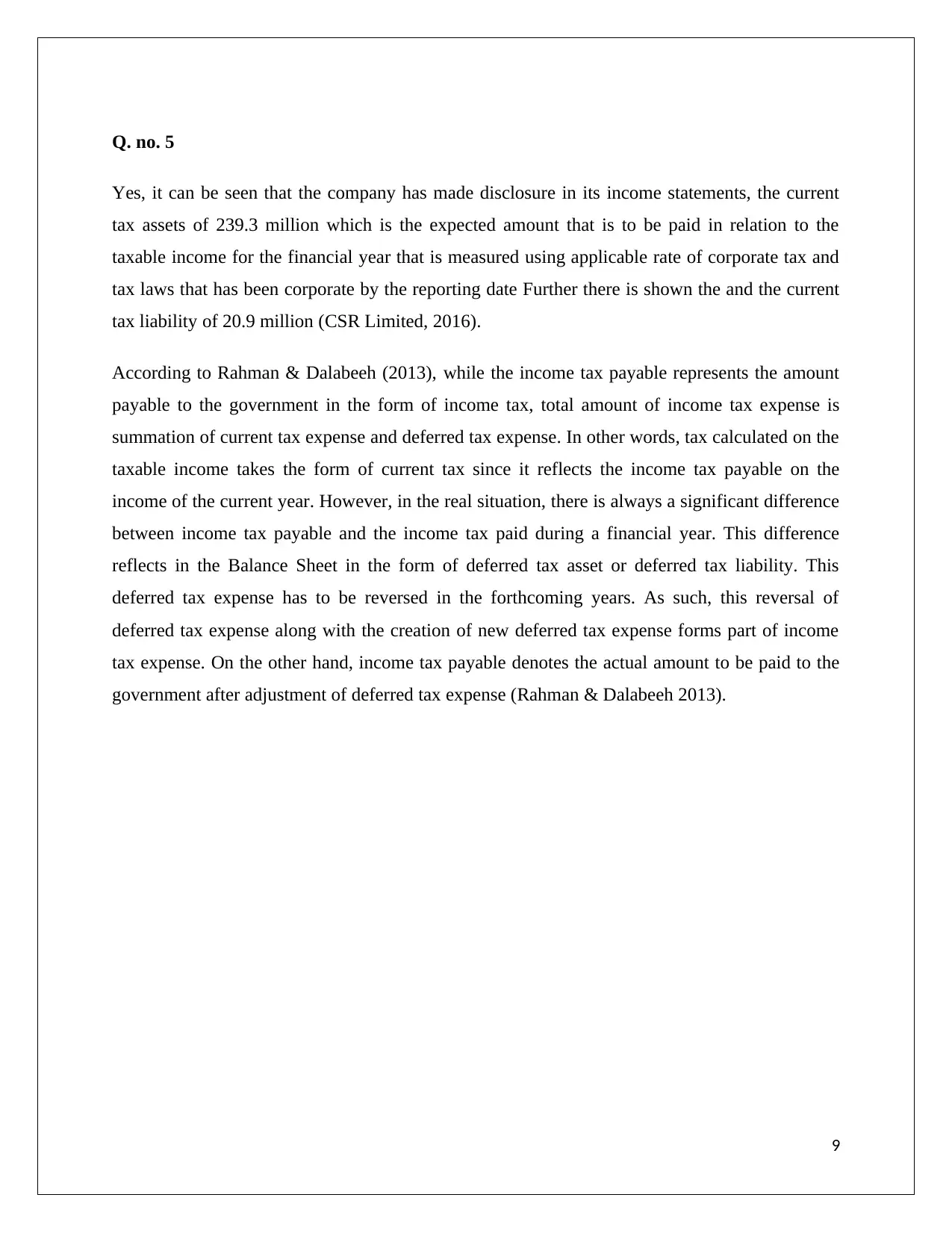
Q. no. 5
Yes, it can be seen that the company has made disclosure in its income statements, the current
tax assets of 239.3 million which is the expected amount that is to be paid in relation to the
taxable income for the financial year that is measured using applicable rate of corporate tax and
tax laws that has been corporate by the reporting date Further there is shown the and the current
tax liability of 20.9 million (CSR Limited, 2016).
According to Rahman & Dalabeeh (2013), while the income tax payable represents the amount
payable to the government in the form of income tax, total amount of income tax expense is
summation of current tax expense and deferred tax expense. In other words, tax calculated on the
taxable income takes the form of current tax since it reflects the income tax payable on the
income of the current year. However, in the real situation, there is always a significant difference
between income tax payable and the income tax paid during a financial year. This difference
reflects in the Balance Sheet in the form of deferred tax asset or deferred tax liability. This
deferred tax expense has to be reversed in the forthcoming years. As such, this reversal of
deferred tax expense along with the creation of new deferred tax expense forms part of income
tax expense. On the other hand, income tax payable denotes the actual amount to be paid to the
government after adjustment of deferred tax expense (Rahman & Dalabeeh 2013).
9
Yes, it can be seen that the company has made disclosure in its income statements, the current
tax assets of 239.3 million which is the expected amount that is to be paid in relation to the
taxable income for the financial year that is measured using applicable rate of corporate tax and
tax laws that has been corporate by the reporting date Further there is shown the and the current
tax liability of 20.9 million (CSR Limited, 2016).
According to Rahman & Dalabeeh (2013), while the income tax payable represents the amount
payable to the government in the form of income tax, total amount of income tax expense is
summation of current tax expense and deferred tax expense. In other words, tax calculated on the
taxable income takes the form of current tax since it reflects the income tax payable on the
income of the current year. However, in the real situation, there is always a significant difference
between income tax payable and the income tax paid during a financial year. This difference
reflects in the Balance Sheet in the form of deferred tax asset or deferred tax liability. This
deferred tax expense has to be reversed in the forthcoming years. As such, this reversal of
deferred tax expense along with the creation of new deferred tax expense forms part of income
tax expense. On the other hand, income tax payable denotes the actual amount to be paid to the
government after adjustment of deferred tax expense (Rahman & Dalabeeh 2013).
9
⊘ This is a preview!⊘
Do you want full access?
Subscribe today to unlock all pages.

Trusted by 1+ million students worldwide
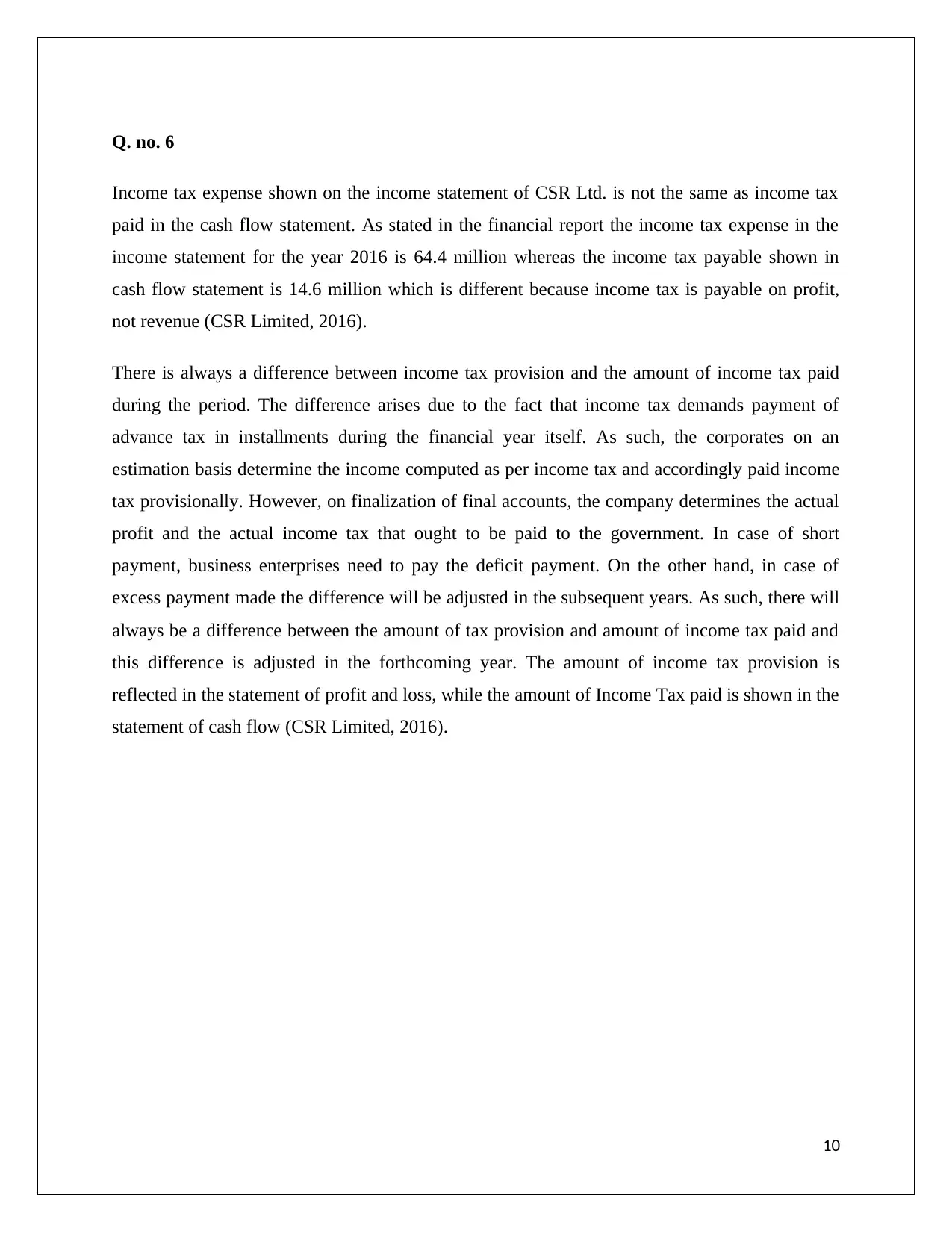
Q. no. 6
Income tax expense shown on the income statement of CSR Ltd. is not the same as income tax
paid in the cash flow statement. As stated in the financial report the income tax expense in the
income statement for the year 2016 is 64.4 million whereas the income tax payable shown in
cash flow statement is 14.6 million which is different because income tax is payable on profit,
not revenue (CSR Limited, 2016).
There is always a difference between income tax provision and the amount of income tax paid
during the period. The difference arises due to the fact that income tax demands payment of
advance tax in installments during the financial year itself. As such, the corporates on an
estimation basis determine the income computed as per income tax and accordingly paid income
tax provisionally. However, on finalization of final accounts, the company determines the actual
profit and the actual income tax that ought to be paid to the government. In case of short
payment, business enterprises need to pay the deficit payment. On the other hand, in case of
excess payment made the difference will be adjusted in the subsequent years. As such, there will
always be a difference between the amount of tax provision and amount of income tax paid and
this difference is adjusted in the forthcoming year. The amount of income tax provision is
reflected in the statement of profit and loss, while the amount of Income Tax paid is shown in the
statement of cash flow (CSR Limited, 2016).
10
Income tax expense shown on the income statement of CSR Ltd. is not the same as income tax
paid in the cash flow statement. As stated in the financial report the income tax expense in the
income statement for the year 2016 is 64.4 million whereas the income tax payable shown in
cash flow statement is 14.6 million which is different because income tax is payable on profit,
not revenue (CSR Limited, 2016).
There is always a difference between income tax provision and the amount of income tax paid
during the period. The difference arises due to the fact that income tax demands payment of
advance tax in installments during the financial year itself. As such, the corporates on an
estimation basis determine the income computed as per income tax and accordingly paid income
tax provisionally. However, on finalization of final accounts, the company determines the actual
profit and the actual income tax that ought to be paid to the government. In case of short
payment, business enterprises need to pay the deficit payment. On the other hand, in case of
excess payment made the difference will be adjusted in the subsequent years. As such, there will
always be a difference between the amount of tax provision and amount of income tax paid and
this difference is adjusted in the forthcoming year. The amount of income tax provision is
reflected in the statement of profit and loss, while the amount of Income Tax paid is shown in the
statement of cash flow (CSR Limited, 2016).
10
Paraphrase This Document
Need a fresh take? Get an instant paraphrase of this document with our AI Paraphraser

Q. no. 7
According to Astrauskaitė & Paškevičius (2016), the treatment of taxable income or income
calculated as per provisions of income tax and amount of income tax payable to the government
in the annual report of CSR Ltd. is quite amazing and satisfactory. Companies has pay taxes on
its net income derived after settlement of all the expenses as required under applicable tax laws.
For CSR Limited, during the year 2016 the taxable income and tax payable both are nil because
company has claim tax deductions and also settle the previous year’s tax losses which decreases
the current tax liability of the company like, tax depreciation, certain restructuring costs and
payments of asbestos claims settlements (Astrauskaitė & Paškevičius 2016).
11
According to Astrauskaitė & Paškevičius (2016), the treatment of taxable income or income
calculated as per provisions of income tax and amount of income tax payable to the government
in the annual report of CSR Ltd. is quite amazing and satisfactory. Companies has pay taxes on
its net income derived after settlement of all the expenses as required under applicable tax laws.
For CSR Limited, during the year 2016 the taxable income and tax payable both are nil because
company has claim tax deductions and also settle the previous year’s tax losses which decreases
the current tax liability of the company like, tax depreciation, certain restructuring costs and
payments of asbestos claims settlements (Astrauskaitė & Paškevičius 2016).
11
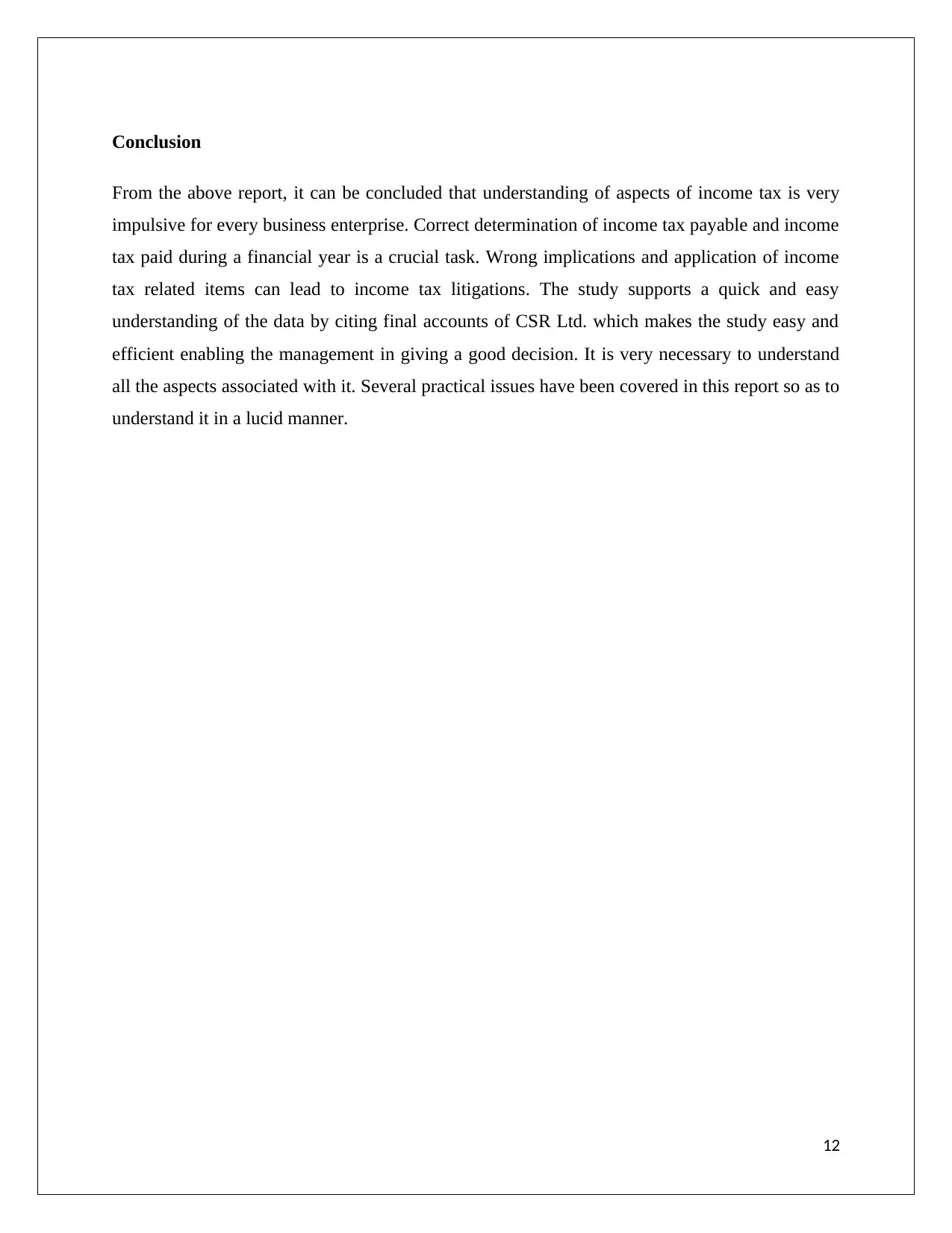
Conclusion
From the above report, it can be concluded that understanding of aspects of income tax is very
impulsive for every business enterprise. Correct determination of income tax payable and income
tax paid during a financial year is a crucial task. Wrong implications and application of income
tax related items can lead to income tax litigations. The study supports a quick and easy
understanding of the data by citing final accounts of CSR Ltd. which makes the study easy and
efficient enabling the management in giving a good decision. It is very necessary to understand
all the aspects associated with it. Several practical issues have been covered in this report so as to
understand it in a lucid manner.
12
From the above report, it can be concluded that understanding of aspects of income tax is very
impulsive for every business enterprise. Correct determination of income tax payable and income
tax paid during a financial year is a crucial task. Wrong implications and application of income
tax related items can lead to income tax litigations. The study supports a quick and easy
understanding of the data by citing final accounts of CSR Ltd. which makes the study easy and
efficient enabling the management in giving a good decision. It is very necessary to understand
all the aspects associated with it. Several practical issues have been covered in this report so as to
understand it in a lucid manner.
12
⊘ This is a preview!⊘
Do you want full access?
Subscribe today to unlock all pages.

Trusted by 1+ million students worldwide
1 out of 13